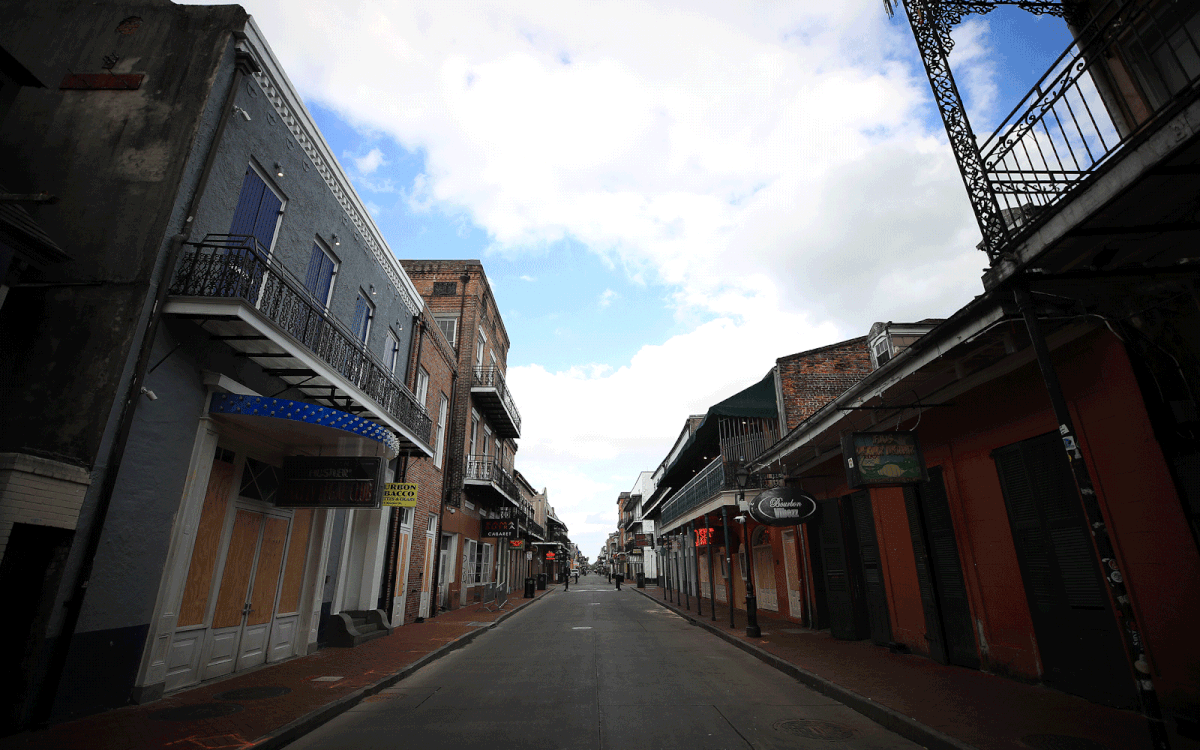
By Alison Fox
Travel has been put on the back burner and in many places small novelties like taking a walk have become monumental means of escapism. This new world may be temporary, but for now it is absolutely necessary as confirmed cases in the U.S. climbed to more than 450,000, including more than 16,000 deaths, according to Johns Hopkins University, which tracks the virus.
Below is a state-by-state breakdown of the number of cases and policies in place.
Alabama

Number of Cases: More than 2,800, Alabama Department of Public Health
Order in Place: A public health emergency was declared on March 13 and on April 4 all Alabama residents were told to stay at home except for “essential activities,” including getting food and medical supplies along with bookstores, liquor stores, and gun stores. While attending religious services or things like weddings and funerals are allowed, these are limited to less than 10 people.
Alaska
Number of Cases: More than 230, Alaska Department of Health and Social Services
Order in Place: Alaska has had a health mandate in place since March 28, ordering people to limit “intrastate travel” to slow the spread of the virus except for essential activities like getting food and gas. All gatherings with people that don’t live in the same household, including weddings and religious gatherings, were ordered to “cease” and anyone who violates the orders “may, under certain circumstances, also be criminally prosecuted for Reckless Endangerment.” While a big Alaskan vacation isn’t necessarily possible right now, it’s easy to explore the glaciers and Kenai Fjords virtually from home.
Arizona
Number of Cases: More than 2,500, Arizona Department of Health Services
Order in Place: Arizona issued a “Stay home, Stay healthy, Stay connected” executive order that went into effect on March 31, limiting movement to essential services, including obtaining supplies and “constitutionally protected activities such as speech and religion.” Additionally, Arizona allows essential businesses to remain open, which also happen to include hiking trails and golf courses with restrictions on food and beverage service.
Arkansas
Number of Cases: More than 1,100, Arkansas Department of Health
Order in Place: Arkansas does not have a statewide order for people to stay home, but has closed certain businesses, including gyms and casinos, and closed restaurants to dine-in services. The state has closed public schools through the end of the school year and limited hotels and vacation rentals to only rent to certain occupations, including healthcare workers, airline crew, journalists, and hospital patients and their families. While gatherings of 10 or more people in a confined space were prohibited as of April 6, the order did not apply to places of worship.
California

Number of Cases: More than 16,900, California Department of Public Health
Order in Place: An order to stay home was issued on March 19. A total of 16 critical infrastructure sectors were exempt, including the food and agriculture sector as well as the healthcare and public health sector. The state determined all “non-essential gatherings should be postponed or canceled,” including concerts, gyms, and theaters. And while restaurants are closed to dining in, Californians can order their meals along with a glass of wine for take-out.
Colorado
Number of Cases: More than 5,600, Colorado Department of Public Health and Environment
Order in Place: Colorado issued a statewide stay-at-home order that went into effect on March 26. Residents are being told to stay home as much as possible and only go out for essential activities, practicing social distancing when they do. Critical businesses, which in Colorado includes marijuana dispensaries, and solo outdoor activities, including nordic skiing and snowshoeing, are allowed. And as a warning to residents, state reps wrote: “Do not try to bend the rules or find loopholes.”
Connecticut
Number of Cases: More than 9,700, Connecticut’s official state website
Order in Place: The state has had a “Stay Safe, Stay Home” order in effect since March 23. All non-essential businesses were told to close and people are being encouraged to work from home, only leaving their homes for necessary errands or services. The state also placed restrictions on hotels and other vacation rentals, designating them only for certain instances, including for healthcare workers, out-of-state employees working on COVID-19 operations, and Connecticut residents who need to self-isolate.
Delaware
Number of Cases: More than 1,200, Delaware Division of Public Health
Order in Place: As of March 24, Delaware residents were told to “shelter in place of residence,” especially those who are at high risk of getting severely sick from COVID-19. The state’s beaches have been closed, but are available for exercise or walking dogs, and gatherings are limited to no more than 10 people through May 15. On April 6, the state went further by banning all hotels and short-term rentals with the exception of guests like essential workers and journalists.
Florida

Number of Cases: More than 15,800, Florida Department of Health
Order in Place: On April 1, Florida put an order in place telling residents to stay at home unless they were participating in essential activities, which were defined as including attending religious services in a house of worship along with outdoor recreational activities like swimming and walking. The state also suspended vacation rentals — not including hotels — and prohibited them from accepting new guests. But if you’re looking for a little escape and are not in Florida, you can always experience the state’s beaches online with 360-degree images.
Georgia
Number of Cases: More than 10,500, Georgia Department of Public Health
Order in Place: While Georgia issued a statewide shelter in place order that went into effect on April 3, local officials criticized the governor for reversing restrictions like beach closures in the process, Time reported. The current executive order requires that businesses that are not considered “critical infrastructure” keep their operations to a “minimum basic” level. Those who can’t go out, however, can live vicariously through two puppies who toured the closed Georgia Aquarium.
Hawaii
Number of Cases: More than 430, State of Hawaii Department of Health
Order in Place: Hawaii issued an order telling residents to stay at and work from home starting March 25. Like many states, essential activities are exempt, but in Hawaii outdoor exercise including surfing and swimming is also OK. Anyone who doesn’t comply with the order would face misdemeanor charges, according to the state. Further, on April 1 Hawaii started requiring people who travel between the islands to self-quarantine for 14 days. But even from home you can throw a great DIY luau (just break out the rum).
Idaho
Number of Cases: More than 1,200, Idaho Division of Public Health
Order in Place: Idaho issued a stay-home order effective March 25, which requires all residents to self-isolate and work from home as much as possible. Like other states, restaurants are limited to take-out or delivery, grocery stores are considered essential, and residents are allowed to exercise outdoors but must practice social distancing.
Illinois

Number of Cases: More than 16,400, Illinois Department of Public Health
Order in Place: A stay at home order went into effect in Illinois on March 21, which prohibited most public or private gatherings of any size. To that end, facilities like playgrounds and museums were ordered to close. Additionally, essential businesses were allowed to remain open, which in Illinois include grocers as well as licensed cannabis dispensaries.
Indiana
Number of Cases: More than 6,300, Indiana State Department of Health
Order in Place: Since March 24, ‘Hoosiers’ in Indiana have been told to stay home and facilities like playgrounds and campgrounds (unless it is your primary residence) have been closed. Elderly or vulnerable residents in the state have been told to take extra precautions and only leave home when absolutely necessary such as to seek medical care. Businesses that provide necessities (like food) are allowed to stay open, but told to limit their hours and implement specific hours for elderly and vulnerable people.
Iowa
Number of Cases: More than 1,200, Iowa’s Coronavirus Website
Order in Place: Iowa does not have a statewide stay at home order, but the state has implemented several closures, including gyms and swimming pools, and limited restaurants to take-out. On April 7, the state extended closures to several institutions, including malls, tobacco stores, bingo halls, toy stores, playgrounds, and campgrounds. The state has also prohibited gatherings of more than 10 people, including for religious or recreational reasons.
Kansas
Number of Cases: More than 1,100, Kansas Department of Health and Environment
Order in Place: A statewide stay at home order has been in place in Kansas since March 30, prohibiting anyone from leaving their home to go to work unless they are performing an essential function. The order allows for things like funerals and does not impose size restrictions on religious services, but requires that everyone keep a six foot distance between them. Unique to Kansas, the order also specifically allows for turkey hunting as long as social distancing is observed as it is an outdoor activity.
Kentucky
Number of Cases: More than 1,400, Kentucky Department for Public Health
Order in Place: Kentucky’s “healthy at home” order went into effect on March 26, allowing only “life-sustaining businesses” to remain open as well as firearm sales. On April 3, the state instituted a curfew on all state parks, forcing them to close at 7 p.m. and shuttering campgrounds and lodges there to overnight stays. Further, Kentucky residents were told not to travel outside the state except in instances like obtaining supplies, including groceries and medicine, and when required for employment.
Louisiana

Number of Cases: More than 18,200, Louisiana Department of Health
Order in Place: Louisiana put a stay at home order in place on March 23. As part of the order, gatherings of 10 or more people have been suspended and residents are being told to stay home unless they are traveling for certain activities, including obtaining food or going to or from a relative’s house. The state has closed things like playgrounds, malls, and personal grooming businesses.
Maine
Number of Cases: At least 560, Maine Department of Health and Human Services
Order in Place: The state’s “Stay Healthy at Home” directive went into effect on April 2. The order requires any essential business that stays open to limit the number of people inside, depending on the size of the business, and to try to implement curbside pickup or delivery options. In Maine — known for its lobsters, of course — outdoor activities are allowed, including fishing, but the state requires that people observe social distancing as they do it. Additionally, Maine requires anyone arriving in the state to self-quarantine for 14 days. And starting April 5, the state prohibited hotels from accepting reservations.
Maryland
Number of Cases: More than 6,100, Maryland Department of Health
Order in Place: Maryland issued a stay at home order that went into effect on March 30, prohibiting all gatherings of more than 10 people, including for social or religious purposes. Additionally, the state closed several businesses, including golf courses and campgrounds. The state is cracking down on people who violate the order, so far charging more than a dozen people with doing so, The Baltimore Sun reported.
Massachusetts
Number of Cases: More than 18,900, Massachusetts Department of Public Health
Order in Place: On March 24, Massachusetts issued a “stay-at-home advisory,” which the state said was “especially” for those who are over 70 years old or who have underlying health conditions. All residents were told to stay home except for absolutely necessary activities and those who are compromised were told to ask about special hours at places like grocery stores and pharmacies. Additionally, people were told not to gather in groups of more than 10 and parents were told not to schedule playdates for children.
Michigan
Number of Cases: More than 21,500, State of Michigan
Order in Place: Michigan enacted a stay at home order on March 24 that prohibits in-person work that is “not necessary to sustain or protect life” as well as gatherings of any size of people who are not in the same household. While Michiganders can go to the grocery store, pick up take-out food, or fill their cars with gas, they are not allowed to visit someone in the hospital or go to the mall. Residents — and anyone outside Michigan, for that matter — can virtually visit the relaxing lavender fields at a family-owned flower field in the state and dream of better days ahead.
Minnesota
Number of Cases: More than 1,200, Minnesota Department of Health
Order in Place: Starting March 27, Minnesota put a statewide stay at home order into place called “#StayHomeMN.” People are allowed to leave their homes for outdoor activities like hiking and hunting, as well as getting groceries or taking care of healthcare needs. Additionally, the state allows for tribal activities within the boundaries of a tribal reservation.
Mississippi
Number of Cases: More than 2,200, Mississippi State Department of Health
Order in Place: Mississippi enacted a “shelter in place” order on April 3, telling people to stay home and prohibiting most gatherings of 10 or more people. Additionally, all playgrounds, beaches and lakes are closed to the public, according to the order. While the state recommends not attending churches, it does not specifically prohibit it, but says “social distancing must be practiced at all gatherings.”
Missouri
Number of Cases: More than 3,500, Missouri Department of Health and Senior Services
Order in Place: The state issued a “Stay Home Missouri” order that went into effect on April 6. The order allows people to leave their homes for groceries and to get take-out at restaurants, as well as attend worship services as long as no more than 10 people are in any single place at once. The order allows all businesses to stay open as long as no more than 10 people are there at once, including restaurants and businesses not deemed essential.
Montana
Number of Cases: More than 350, Department of Public Health and Human Services
Order in Place: Montana issued a stay at home order that went into effect on March 28, prohibiting gatherings of any size for people outside of a household. Unique to Montana, the state specifies horse owners can continue to work with horses, but “discourages” activities that would bring multiple people together in one location. While Montanans are able to go outside for outdoor exercise, the state is discouraging them from participating in potentially dangerous activities, including some backcountry skiing, as it could stress first responders. Additionally, anyone who comes to Montana for non-work-related travel must self-quarantine for 14 days.
Nebraska
Number of Cases: More than 560, Nebraska Department of Health and Human Services
Order in Place: Nebraska does not have a statewide stay at home order in place. Rather, the state has enacted “Directed Health Measures.” The dates the measures went into effect differ by county. As part of these measures, gatherings of 10 or more people are prohibited — including weddings and funerals — but this does not apply to malls, “typical office environments,” or courts. Bars and restaurants are limited to take-out or delivery.
Nevada
Number of Cases: More than 2,400, Nevada Health Response
Order in Place: Nevada issued a formal stay at home order on April 1, after asking people to stay home since March 17. The state has ordered nonessential businesses to close, including casinos and liquor stores, but is allowing certain businesses to stay open, including supermarkets as well as licensed cannabis dispensaries offering delivery services, and pawnbrokers.

New Hampshire
Number of Cases: More than 780, New Hampshire Department of Health and Human Services
Order in Place: New Hampshire enacted a stay at home order for all residents on March 27. People are allowed to leave their homes to get essential goods like food, visit a spouse, parent, or child, and to pick up take-out food. The state has also limited gatherings of 10 or more people, including for religious services.
New Jersey
Number of Cases: More than 51,000, New Jersey Department of Health
Order in Place: New Jersey has had a stay at home order in place since March 21, closing all nonessential businesses and telling people to stay home. Essential businesses, including grocery stores, have to limit the number of customers to 50 percent capacity. Since then, the state has gone further and closed all state parks, forests, and county parks.
New Mexico
Number of Cases: More than 860, New Mexico Department of Health
Order in Place: New Mexico issued a stay at home order that went into effect on March 23, telling residents to stay home and only go out when “absolutely necessary for their health, safety, or welfare.” Businesses considered essential are allowed to remain open, including restaurants for take-out or delivery as well as local breweries and distilleries for carry out. All gatherings of five or more people are prohibited, with the exception of places of worship, and hotels were instructed to cap occupancy rates at 50 percent.
New York

Number of Cases: More than 159,900, New York State Department of Health
Order in Place: New York, which has been the hardest hit state in the country, has had a “New York State on PAUSE” order in place since March 22, which closed all non-essential businesses and banned all non-essential gatherings of any size and for any reason. Many cases in New York have been concentrated in New York City where charities and volunteers have stepped up to help people in need. Additionally, New York announced “Matilda’s Law” (named for Gov. Andrew Cuomo’s mother) that requires those over 70 and other vulnerable people with compromised immune systems to stay home and only see people in emergency situations.
North Carolina
Number of Cases: More than 3,600, North Carolina Department of Health and Human Services
Order in Place: North Carolina has had a statewide stay at home order in place since March 30. The order reduced gatherings to no more than 10 people and instructed residents not to go out unless visiting an essential business. In North Carolina, these businesses include grocery stores and places of worship (which also have to abide by the 10 people or less rule).
North Dakota
Number of Cases: More than 260, North Dakota Department of Health
Order in Place: North Dakota does not have a statewide stay at home order. Rather, the state closed certain businesses last month and on April 6 suspended visitation to places like nursing homes. Restaurants in the state are only open to take-out or delivery while places like gyms and movie theaters were forced to close. While there is no official stay at home order, the state has told people to “step up social distancing efforts” and asked them to “refrain from holding gatherings of 10 people or more.”
Ohio
Number of Cases: More than 5,500, Ohio Department of Health
Order in Place: Ohio has had a stay at home order in place since March 23. Gatherings of any number are prohibited and facilities like playgrounds, gyms, and movie theaters are closed. Religious gatherings in Ohio, however, are considered essential and exempt from the order. Those who are elderly or immunocompromised were told to take extra precautions.
Oklahoma
Number of Cases: More than 1,600, Oklahoma State Department of Health
Order in Place: Oklahoma’s “Safer at Home” order only applies to people 65 or older, immunocompromised people, or those with pre-existing conditions. Under the order, several stores were labeled as essential and allowed to remain open, including clothing stores, electronic stores, furniture stores, and bookstores. Additionally, social gatherings of more than 10 people were prohibited.
Oregon
Number of Cases: More than 1,300, Oregon Health Authority
Order in Place: Oregon has had a stay at home order in place since March 23. Under the order, residents are allowed to go to places like grocery stores and get take-out from restaurants. However, gatherings of any size considered nonessential — like parties — are prohibited, and facilities like malls, salons, and yoga studios are closed. Additionally, the state closed all state parks, pools, and playgrounds.
Pennsylvania
Number of Cases: More than 18,200, Pennsylvania Department of Health
Order in Place: Pennsylvania enacted a statewide stay at home order on April 1. This follows a similar order placed on several counties in the state. Residents are able to leave home for things like getting necessary supplies and outdoor activities while maintaining social distancing. Religious institutions are exempt from the order, but religious leaders are being encouraged to find alternatives to in-person gatherings, according to the state.
Rhode Island
Number of Cases: More than 1,700, State of Rhode Island Department of Health
Order in Place: On March 28, Rhode Island enacted a stay at home order, telling residents they should only go out if traveling to work, for medical treatments, or for necessities like food. Gatherings were restricted to five people or less, including in parks and places of worship, and nonessential businesses were closed. Additionally, the state ordered anyone who came there from another state for a non-work-related reason to self-quarantine for 14 days.
South Carolina
Number of Cases: More than 2,700, South Carolina Department of Health and Environmental Control
Order in Place: On April 7, South Carolina’s “home or work order” went into effect, telling people to limit social interaction, and practice “social distancing.” Nonessential businesses in the state have been closed, including tourist attractions, gyms, and retailers like clothing stores. Under the order, residents of South Carolina can leave home to get essential goods like food as well as attend religious services in a house of worship.
South Dakota
Number of Cases: More than 440, South Dakota Department of Health
Order in Place: South Dakota does not have a statewide stay at home order. Instead, on April 6, the state directed people in two counties who are over 65 years old or with underlying conditions to stay home. This applies to Minnehaha and Lincoln counties, which include the state’s largest city of Sioux Falls. Last month, South Dakota told “enclosed retail” businesses, including restaurants, bars, gyms, and casinos to “suspend or modify business practices as recommended by CDC guidance that involve 10 or more people to be in an enclosed space where physical separation of at least six feet is not possible.”
Tennessee
Number of Cases: More than 4,600, Tennessee Department of Health
Order in Place: Tennessee’s “safer at home” order went into effect on March 31. Under the order, residents were told that while they should stay home except for essential services, even those should be as limited as possible. Tennessee said residents could get outside for solo exercise, including swimming, kayaking, and golf, but that playgrounds were not considered essential. Visiting a place of worship as well as going to weddings or funerals were exempt from the order. Residents were told health guidelines should be “followed to the greatest extent practicable.”
Texas
Number of Cases: More than 10,200, Texas Department of State Health Services
Order in Place: On April 2, Texas implemented an order telling residents to “minimize social gatherings and minimize in-person contact with people who are not in the same household.” In Texas, essential services are allowed, including performing healthcare occupations as well as attending religious services in a house of worship. The order also allows for people to take part in outdoor activities, like visiting parks, hunting, and fishing.
Utah
Number of Cases: More than 1,900, Utah Department of Health
Order in Place: Utah issued a “Stay Safe, Stay Home” order on March 26, but specified it is “not to be confused with a shelter-in-place order.” Residents in the state are told to work from home and “stay home as much as possible” while parents are told not to arrange playdates or take children to playgrounds. Additionally, those who are at higher risk in the state are advised to take extra precautions.
Vermont
Number of Cases: More than 620, Vermont Department of Health
Order in Place: Vermont enacted a “Stay home, Stay Safe” order on March 25. Residents were told to stay home except for when accessing essential services like groceries or medical care. Additionally, Vermont closed all hotels and home rentals except for when they are directly supporting the COVID-19 response, including providing housing for healthcare workers. The state also told religious organizations to suspend in-person worship, and closed popular recreational facilities like golf courses and ski resorts.
Virginia
Number of Cases: More than 4,000, Virginia Department of Health
Order in Place: Virginia has had a statewide stay at home order in place since March 30. The order specifies that all Virginians need to remain at home except to buy things like groceries and seek medical care. The order prohibits gatherings of more than 10 people, including for parties or religious events. Beaches are closed except for exercising and fishing.
Washington
Number of Cases: More than 9,000, Washington State Department of Health
Order in Place: Washington was one of the first states to be hit hard with COVID-19 cases and responded with a “Stay Home, Stay Healthy” order on March 23. The order told Washington residents to stay home except for essential activities, including getting food and obtaining medical care as well as outdoor exercise where social distancing is observed. The order also prohibited gatherings of any size, including for everything from social reasons to faith-based ones.
West Virginia
Number of Cases: More than 520, West Virginia Department of Health and Human Resources
Order in Place: West Virginia has had a stay at home order in place since March 24, which tells residents to stay home unless performing an essential activity. The order allows for outdoor exercise while observing social distancing, but closed state park lodges and restrooms. Places of worship and religious gatherings, along with weddings and funerals, are exempt from the order, but told to practice social distancing “to the greatest extent possible.”
Wisconsin
Number of Cases: More than 2,800, Wisconsin Department of Health Services
Order in Place: Wisconsin’s “safer at home” order went into effect on March 25, which told people to stay home and prohibited gatherings of any size, except for religious gatherings, weddings, and funerals, which were limited to less than 10 people. Additionally, all playgrounds and swimming pools were closed, along with places like gyms and spas.
Wyoming
Number of Cases: More than 230, Wyoming Department of Health
Order in Place: Wyoming does not have a statewide stay at home order in place. Instead, the governor of the state has asked residents to “stay home whenever possible,” adding that “voluntary actions and discipline” will make a difference. Additionally, on March 20, Wyoming closed restaurants for dine-in service, along with places like theaters, gyms, and museums.
The information in this article reflects that of the publishing time above. However, as statistics and information regarding coronavirus rapidly change, some figures may be different from when this story was originally posted. While we strive to keep our content as up to date as possible, we also recommend visiting sites like the CDC or websites of local health departments.
https://www.travelandleisure.com/travel-news/what-to-know-about-each-state-during-the-coronavirus?did=511440-20200410&utm_campaign=just-in_newsletter&utm_source=travelandleisure.com&utm_medium=email&utm_content=041020&cid=511440&mid=32136905067

Be the first to comment